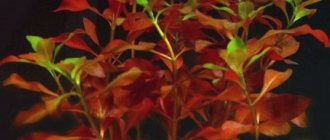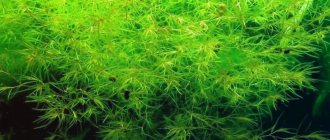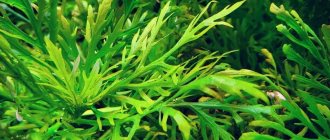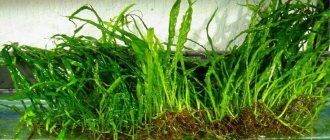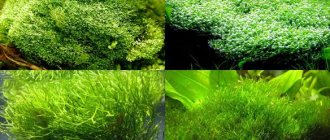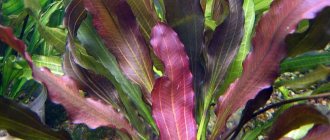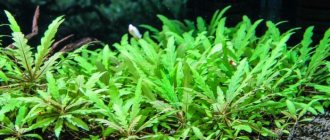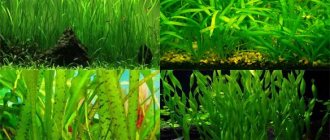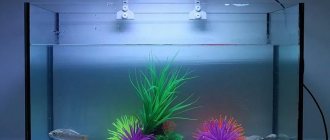04/20/2019Aquarium plants0
Aquarium lovers use aquatic vegetation to decorate the pond and saturate it with oxygen. The amazing Wolfia plant is so small that its leaves can only be seen using magnifying devices. Despite its tiny size, it is useful for aerating the tank and is an excellent source of food for a large number of fish.
- 1 Botanical description and natural habitat
- 2 Mr. Tail recommends: beneficial properties of Wolfia
- 3 Basics of aquarium keeping, compatibility
- 4 Reproduction and planting
- 5 Diseases and pests
Description
The genus Wolfia is part of the Araceae family, uniting 11 species of aquatic flora.
In nature, plants live on the surfaces of small, non- or low-flowing water bodies. Each Wolfie is tiny. The largest specimens barely reach 0.1 cm. But they reproduce so actively that they completely cover vast areas.
Wolffia has a spherical or ellipsoidal shape. The body of the plant (leaf) is colored in various shades of green. These representatives of the flora have no roots. Despite its modest dimensions, the plant is rightfully ranked among the highest flowering plants. Mini-flowers, which cannot be seen with the naked eye, appear rarely.
Since Wolfia contains a large amount of fats and carbohydrates, it becomes an excellent food for fish, amphibians, and ungulates. In folk medicine it is used to heal wounds. In some areas of Africa and Asia, the plant is used as a culinary seasoning.
At the same time, Wolffia poses a serious problem for rice growing. A dense layer of flora “robs” sunlight and carbon dioxide from its neighbors.
Reproduction and planting
The culture is easily propagated by division. Throughout the warm period, from mid-spring to late autumn, the plant actively grows. In home tanks this process occurs continuously.
When purchasing Wolfia for an aquarium at an aquasalon, you don’t have to worry about infecting other plants with any diseases. To be on the safe side, you can plant the newly acquired species in a separate tank for adaptation.
Taking culture from the natural environment is strictly prohibited. In this way, it is possible to infect the inhabitants of the aquarium with parasites.
Growing
Wolfia is suitable for growing in aquariums, paludariums and small open reservoirs. Very often it is used as food for aquarium fish.
Since the plant’s natural habitat is freshwater reservoirs, it needs the same conditions in culture. That is, pure water without the presence of salt.
Wolffia reproduces in two ways. In the first case, the leaf is divided into 2–4 parts. In the second, a microscopic ball is formed on the body, which, after reaching the proper size, separates and exists independently. The reproduction process is ongoing, interrupted only by significant cold weather. During this period, Wolfiya sinks to the bottom.
Mr. Tail recommends: beneficial properties of Wolfia
The rootless plant is extremely healthy and nutritious. The level of protein content can be compared with soybeans. The following areas of application of algae are known:
- It is used as feed. With regular replenishment of the diet of goldfish and African cichlids, their color becomes unusually bright and beautiful. It has been proven that this type of food has a positive effect on the health of pets, increases resistance to disease, and improves immunity.
- The aquatic culture is used as a spice and is consumed by humans. It contains a whole complex of vitamins, including A, group B, as well as C and PP.
- To create shade in the aquarium, some species of Wolffia are also grown. It evenly covers the surface, creating protection from ultraviolet radiation, which is necessary for shade-loving algae and fish.
- The cleaning properties of the culture are known. The sticky layer on the surface of the records collects dust and small pieces of debris that fall into the tank. The substance secreted by the culture resembles wax.
- The plant is used in medicine. Its wound healing properties are well known. For burns and festering wounds, medications prepared using Wolfia are prescribed.
First steps after purchase
Wolfia is not susceptible to diseases and pest attacks. Therefore, there is no obstacle to placing the plant in the aquarium immediately. However, it is advisable to place beginners in a separate container filled with “aquarium” water for speedy acclimatization.
Long-term isolated keeping is also recommended in cases where Wolffia is purchased exclusively as food. You will need a shallow vessel with a wide surface, placed in a well-lit place. When the number of plants increases, Wolfia can be moved to the aquarium.
Wolfia rootless
Wolffia rootless for reservoirs
Wolffia (lat. Wolffia) is a genus of aquatic plants from the duckweed subfamily (Lemnoideae) of the Araceae family. About 10 species. Includes the smallest flowering plants on Earth, such as Wolfia globulus. Wolfia rootless is a plant that floats on the surface of the water. It is the smallest flowering plant on Earth. Depending on the type, wolffia can have a size from 0.4 to 1.5 millimeters. The most common species, most often cultivated in aquariums, is Wolffia rootless. Outwardly, it looks like small green round plates that are constantly on the surface of the water.
Wolfia rootless photo
In its habitat, Wolffia rootless is found in small tropical forest reservoirs of Asia, Africa, and the Mediterranean. In Russia it is occasionally found in temperate latitudes. Wolffia was discovered near Bryansk, Voronezh, Lipetsk and Kursk. The greatest concentration in Russia is in the oxbow lakes of the Psel River. Selects only standing water. Does not tolerate flowing water.
Wolfia rootless photo
Cultivation and breeding of Wolffia by aquarists is non-decorative in nature. Rarely does anyone grow wolfia as a decoration for a pond. It is mainly grown as a supplementary plant food, as living cover for fry, or as a shade mat where it is required for certain plant species. Wolfia easily tolerates a drop in temperature to 14-16 degrees. Its growth does not stop. Wolffia is undemanding in terms of water composition, but grows better in soft, slightly acidic water (pH, kH below 7 degrees). Despite the fact that the plant does not tolerate running water, it requires constant vibration of the surface, otherwise hyphenation may occur. In favorable conditions, Wolffia grows very quickly, covering the entire surface of the water. Therefore, this plant requires strict control. It is better to grow wolffia in separate containers in the absence of herbivorous fish or in a separate reservoir. But if this is not possible, wolffia is grown in mesh cages placed in a common aquarium.
Wolfia photo
Interestingly, Wolfia rootless contains as much plant protein as soybeans. The plant is rich in carbohydrates, vitamins A, B2, PP and B6. It is considered one of the best feeds for herbivorous fish. If you feed live wolffia, you must ensure that it is eaten completely. Otherwise, the wolffia, when multiplying, can quickly cover the entire surface of the aquarium.
Wolfia has the smallest flower on Earth. The structure of Wolffia consists of fused leaf formations. In the lower thickened part of the leaves there is a pocket in which buds are laid, giving rise to new plants, and on the upper part there is a flower pit. Wolffia blooms so rarely that many botanists spend half their lives trying to find its flower, which is no wonder, since its size is smaller than the head of a pin.
Wolfia video review
Cool videos about plants from FanFishki
Subscribe to our YouTube channel so you don't miss anything
PRACTICAL NOTE ON GROWING AQUARIUM PLANTS
This note is posted in all FanFishka articles dedicated to aquarium plants. This is a cheat sheet with a link that will help you grow any aquarium plant and herbalist of any complexity.
Most of the reference materials are located in the Aquascape , we also recommend our brochure: Aquarium navigator for beginners: “Underwater Gardens of Babylon” .
The formula for success in growing plants can be depicted as follows.
First of all, the proper level of lighting is necessary.
(light intensity - Lumens)
Next, the proper concentration of CO2
Further macro-fertilizers and micro-fertilizers
Water parameters, care and quality water changes
The gradation of this formula is based on the degree of importance. Lighting intensity is primary, and then descending. Therefore, if your plants have holes in the leaves, they have sciatica (crooked) or there are problems with algae, then please do not read the “bad advice” - this is chlorosis (lack of iron), this is a lack of potassium... diarrhea, phimosis and endometriosis )
You always need to solve the problem of setting up an herbalist from major to minor. Plants will die more quickly from a lack of lighting than from a lack of Fe and K. Moreover, the latter are always present in one degree or another in the aquarium, but it is difficult to measure their precise value.
Below, let's go from the main to the minor.
Lighting in an aquarium with plants . Remember, the most important thing in light is its intensity (Lumens)! All other lighting characteristics: spectrum, Kelvin, PAR/PAR, Ra... are important, but secondary. There will be no intensity of lighting, there will be nothing. At the same time, the lighting intensity must be balanced - selected specifically for your project (height of the water column, number and types of plants, daylight hours).
Based on the above, choose aquarium lighting primarily by the number of lumens, and then everything else.
Lighting is the most expensive part. The most budget-friendly solution is to install ordinary construction-street floodlights above the aquarium . Fortunately, they are now very thin and aesthetic. And believe me, under them everything grows with a bang, of course, provided that all the other components are present.
In order not to be unfounded, here are photos of our herbalists, which were grown exclusively under LED spotlights or with their presence.
If you want professional lighting or aesthetics. Then you will have to fork out some money. The amounts can vary quickly from 10,000 to 50,000+ rubles for a 100 liter aquarium. For example, in 2021 we switched to professional lighting - ISTA Titan . Yes, not cheap, but the lamps are Achon! We have grown a professional competitive aquascape under them. That’s why we advise you to pay attention to them.
Well, it’s difficult to advise anything, because... Everyone has different needs and capabilities. In this article we talk about the products of our partners - Tetra , Laguna , ISTA lighting .
We tried to briefly and objectively talk about them. Then it's up to you. In any case, we do not really recommend that you pay attention to handicraft lighting assembly from folk craftsmen. Not all, but as a rule, they shove who knows what kind of diodes into such an assembly, assemble it all on their knees... and believe me, more than once on the forum you hear echoes of the consequences of such a purchase. After all, a company is a company. At a minimum, you are given warranty and post-warranty service.
If you are a beginner, your first herbalist, then LED spotlights are your choice. Let's move on, otherwise this note isn't very short =)
CO2 for aquarium plants . The plant is approximately 90% water, the remaining 10% is dry matter. Of that 10%, 46% is carbon. This is why CO2 supply is so important in a planted aquarium.
Plants in an aquarium obtain carbon “from water” - from carbon-containing compounds. But the natural concentration of C-carbon in water is small and is only sufficient for unpretentious plants, but they, and even more so, will be happy with additional carbon feeding. The supply of CO2 can be provided using mash or a CO2 balloon system , lemon juice or other methods.
The best, professional, simple and budget option is to supply carbon dioxide through a cylinder. One thing, however, is the initial purchase of a set: a cylinder, an MG valve, a diffuser…. will hit the budget.
Is it possible to do without CO2, but for a couple of bushes of simple plants ( cryptocorynes , echinodorus , most ludwigias , etc.).
What balloon systems can you recommend? The most budget option is an assembly from craftsmen who sell CO2 systems in VK and on forums. Everything is very high quality.
If you want a branded item, then we recommend the most inexpensive and at the same time high-quality CO2 systems from ISTA (Taiwan) . We have been using them for 5 years and recommend them to you.
On sale you will find two series of ISTA Aluminum CO2 Cylinder cylinders, with horizontal and vertical threads of 1 and 3 liters.
Fertilizers for an aquarium with plants . All fertilizers, of any brand, can be divided into MACRO-FERTILIZERS and MICRO-FERTILIZERS .
Macro fertilizers are nitrate NO3 and phosphate PO4 from which plants take N-nitrogen and P-phosphorus. These are the most important elements after CO2 - C-carbon.
Remember - Redfield's proportion rules . Always keep it under control and everything will be ok. Right, based on our observations, Redfield’s proportion rules only in full NPC proportions. Incomplete proportion - without carbon C does not give good results.
Micro fertilizers . These are all the other less important elements that are necessary for plants (see link). There is no point in putting too much emphasis on them. Firstly, all of them are contained in one quantity or another in tap water and are restored in the aquarium with changes. Secondly, an overdose of micro very quickly leads to an outbreak of algae.
A common mistake made by beginners is not understanding what they are pouring into the aquarium. For example, let's take such a popular and popular fertilizer as Tetra PlantaMin . Read the product summary at the link - it strengthens, stimulates, and gives a chic body shape.
A beginner, without delving into the essence, uses it and gets an outbreak of algae, writes on the forums - “Like, wow, what a bad Tetra.” And the trouble lies not in the drug, but in a lack of understanding of the nitrogen cycle and balance in the herbalist . The beginner has a Redfield bias (let’s say N and P are generally zero) and instead of making up for the lack of these primary elements, he fills the aquarium with Tetra PlantaMin - a micro-fertilizer (iron, potassium, manganese). As a result, going over the micro is only detrimental, because... plants lack the base - nitrogen and phosphorus.
Thus, you must understand what plants lack and understand fertilizers.
How to understand what plants lack? It's simple. Now the market is filled with a variety of expensive and not so expensive aquarium water tests. We recommend inexpensive domestic ones - VladOx drop tests , they are sold online and offline.
We also recommend, let’s not be afraid of this word, innovative domestic UHE tests . They are currently only sold online.
The minimum set of tests for an herbalist is NO3 and PO4. It is advisable to have the entire nitrogen range: NH4, NO2, NO3. As well as kH and pH tests.
Tests help us monitor the situation in the herbalist, but over time it is advisable to learn to see and feel the aquarium for yourself. With experience you need to move away from “convulsive testing”; the best aquarium test and tool is ourselves.
Let's summarize this part. Macro, it’s macro in Africa too. The link above generally contains a recipe on how to make them yourself. If you are not yet ready for self-mixing, then always and everywhere you will find a line of fertilizers from Tetra: Tetra Planta Macro , Tetra PlantaMicro , substrates, root tablets and much more .
Of course, there are many other brands that produce aquarium fertilizers. There is an opportunity, use even ADA products. All markers are different in taste and color. The main thing is to use it with a clear understanding of what you are using it for and what you want to get in the end.
From the professional line of fertilizers, at an adequate price, we can recommend Prodibo (soils, soils, macro, micro, stimulants, etc.).
So, something like a note turns into the Talmud. Which is not surprising - the topic is very broad. One moment left.
Water parameters for aquarium plants. Link1 and Link2 , please look at these articles, they cover the essence quite well.
Here we note that the quality of photosynthesis is influenced by the process of caring for the aquarium: water parameters (kH, pH below 7), high-quality filtration and aeration, competent and timely water changes.
Please study
Secrets of success
Wolfia does not require specialized care or special living conditions. The plant prefers neutral water, but easily adapts to life in an alkaline or acidic environment. Water hardness is also not of fundamental importance. Wolfia feels comfortable both at 5 and at 20°.
The plant is light-loving; daylight hours should last 10–12 hours. At the same time, direct sunlight damages the decorative effect. For artificial lighting it is better to use fluorescent lamps.
Optimal water temperature is +22–26°C. However, Wolffia is not afraid of warming up to +32°C, and short-term cold snaps up to +14°C. If the temperature drops even lower, the plant goes into winter.
Occasionally, it is advisable to feed Wolffia with diluted mineral fertilizers with microelements.
Content
This plant is highly hardy and can be successfully kept even by a novice aquarist. But to prevent it from dying, it needs to ensure the following:
Water parameters . Hardness and acidity do not matter. They can be anything. The temperature should be no lower than 14 degrees, but with such extreme values, other inhabitants of the aquarium will most likely die;
Required conditions . It is imperative to change the water in the aquarium weekly, about 25-30% of the total volume. It is also advisable to create an easy flow. This will avoid the formation of a bacterial film on wolffia, which can negatively affect metabolism;
Lighting . It is desirable that it be bright. In principle, all floating plants love good light, and wolfia is no exception. She needs the lamp to work for about half a day a day.
The plant has stable growth, independent of the time of year. However, during the winter season it goes into hibernation, sinking to the bottom until spring arrives.
We recommend reading the article: Phoenix Moss: description and maintenance in the aquarium
Possible difficulties
The main difficulty in growing Wolfia is its overactive spread. Very quickly it takes up free space, worsening the life of other aquarium flora. Therefore, if there are no fish in the container, the excess should be removed periodically.
In cases where the inhabitants of the aquarium eat Wolfia faster than it has time to increase in quantity, it is necessary to grow it separately. In addition, keeping plants in cages or ditches gives excellent results.
The danger for Wolffia is the bacterial film.
Periodic surface vibrations and weekly 20% water changes are designed to prevent its occurrence. Editorial team LePlants.ru
Why is Wolffia needed in an aquarium?
It is quite in demand in the aquarium hobby. This unpretentious aquarium plant easily takes root even for beginners. When it grows, it forms a thick and beautiful green carpet on the surface of the water. But, in addition, it also performs several practical functions:
Food for fish . Many aquarists specifically breed this plant in order to add it to the diet of the inhabitants of their aquarium. Wolfia is a storehouse of nutrients and vitamins. Moreover, studies have shown that its regular use makes the color of African cichlids and goldfish brighter;
Creating a shadow . Not all underwater inhabitants like bright lighting. Many fish prefer to be nocturnal and sit in the shade during the day (for example, many catfish, axolotls, black knife). If there are not enough shelters in the aquarium, then the wolffia will become a real salvation for your pet. Moreover, some plants also do not like bright light (for example, Anubias) and quickly die in such conditions. This plant will help to easily protect such flora;
Water purification . Firstly, wolffia, like any flora, grows, for which it needs nitrates and phosphates, which in high levels are dangerous for the inhabitants of the aquarium. Secondly, the plant balls have a sticky composition that attracts various contaminants, including dust.
Conditions of detention
Wolffia rootless can grow in water with different hardness levels. But the ideal living condition is a not too acidic and fairly soft environment. The culture is extremely sensitive to the purity of the liquid, so it needs regular filtration and water replacement. It is important to avoid the development of stagnation in the aquarium, since they contribute to the formation of a bacterial film that is harmful to the plant.
The optimal temperature regime for wolfia is from +18 to +30°C. At lower temperatures, the plant also survives, but the processes of its growth, development, and reproduction slow down significantly.
The plant can do without fertilizers. But additional application of mineral fertilizers will increase the size of Wolffia balls and give them a more saturated green tint. But adding salt to water, on the contrary, can negatively affect the condition and appearance of the crop.
When Wolffia growth slows down, it is recommended to saturate the water using nutrient magnesium and potassium solutions with the addition of microelements and peat extract. From time to time, organic fertilizers will also be useful.
Experienced aquarists recommend periodically stirring the water layers to create an optimal level of aeration. Wolffia also requires cleanliness in the aquarium, timely cleansing of silt and foreign impurities. Good results can be achieved using an ordinary aquarium filter.
The benefits and harms of the plant
The world's smallest flower contains B vitamins, as well as A, C and PP. And in terms of the amount of protein, wolffia can easily compete with soybeans. This is due to the fact that these plants are eaten not only by fish, but also by local aborigines.
Wolffia has excellent cleaning properties, so it is often used to filter various salts in industrial settling tanks.
However, the flower can have a detrimental effect on rice plantations once placed on them. Therefore, in the regions where this crop is grown, Wolffia is constantly being fought.
Wolfia - botanical description and features
Photo: Wolfia
Wolfia (other names: duckweed or water meal) is a small floating aquatic plant. This is a species of monocot from the botanical subfamily Lemnaceae - Lemnaaceae, and belongs to macrophytes. Duckweeds are found in Europe, Asia, America and other parts of the world; they are adapted to variations in geographical and climatic zones. Mooks are a fast-growing angiosperm and will cover ponds or lakes within a few days when growing conditions are favorable. The genus Wolffia is distinguished by its extremely small size and, in addition, the genus has the smallest flowers.
Benefits of Wolffia
Wolfia is a multifunctional plant that is valued by aquarists due to its beneficial qualities:
- Fish food.
- Moderate decorative properties, can be used for aquarium design.
- It is used in southern countries as a food and medicinal plant, which has pronounced anti-inflammatory properties.
- Cleansing and filtering function.
- Natural fertilization of water, carried out due to the ability of leaves to accumulate potassium, nitrogen and phosphorus.
- Shading of the pond.
- Obstacle to active algae growth.
But we must not forget that if it spreads too intensively, Wolffia can cause the death of other aquarium plants due to its shading ability, as well as increased utilization of carbon dioxide.
Wolfia rootless is a cute and very useful aquarium plant, which is loved by aquarists due to its functionality, versatility, and unpretentiousness in everyday life. It is undemanding in terms of water hardness and acidity and can survive even at low temperatures. All that is necessary for the full growth and development of wolffia is intensive lighting, a nutritious and clean habitat, and sufficient water flow.
Reproduction
Wolfia rootless reproduces both by division and with the help of shoots. For independent propagation, it is enough to simply create optimal conditions for the plant - bright lighting and suitable temperature conditions. Reproduction lasts throughout the whole year and can only stop with a significant decrease in temperature.
When purchasing shoots for planting, to comply with safety precautions, you must place them in a separate container, first filling it with water from the aquarium. Such manipulation will avoid accidental infection and at the same time speed up the process of acclimatization of new Wolffia specimens.
It is not recommended to take Wolffia basal from natural reservoirs, since in this case there is a high risk of infection of the aquarium and infestation with parasitic individuals.
Botanical characteristics of Wolffia
Rhizome
— Advertising —
The Wolffia plant grows without roots or rhizomes.
Leaves
Wolfia has no leaves. The leaf-shaped body is called a leaf or scutellum, leaf, plate. This plate is round, up to 1.3 millimeters in diameter. Stem: thin, up to 9 millimeters in length and 1.5 millimeters in width. Thanks to the stem, flour forms star-shaped clusters.
Flower
While other plants produce flowers once or twice or three times a season, wolfia almost never blooms.
Fetus
In technical botanical terms, watermeal fruits are similar to the bladder, single-seeded. The spherical fruit (utrik) contains a tiny, 0.5 mm smooth seed.
Distribution area
The homeland of this culture is the tropical part of North and South America. Wolffia is found on all continents, from Australia to America. Widely distributed in the New World, India, Mediterranean countries and Central Europe. It grows mainly in temperate and tropical zones. On the territory of the Russian Federation - in Bryansk, Voronezh, Kursk, Lipetsk and Tambov regions.
Prefers stagnant bodies of water rich in useful organic matter - ponds, ditches and lakes. This plant is often hidden in a thick carpet of duckweed. Does not survive in running water.
Wolfia aquarium plant
Aquarium lovers use aquatic vegetation to decorate the pond and saturate it with oxygen. The amazing Wolfia plant is so small that its leaves can only be seen using magnifying devices. Despite its tiny size, it is useful for aerating the tank and is an excellent source of food for a large number of fish.
Characteristics and properties
Wolfia rootless belongs to the araceae family, the duckweed subfamily. Freshwater bodies of Asia and Africa are considered the homeland of this perennial crop. In appearance, wolfia resembles closely spaced miniature green balls, but they can also acquire a brownish tint.
The leaf blades are oval in shape. The aquarium plant does not have a developed rhizome; it receives all the necessary nutrition from the aquatic environment. The outer layer has a special waxy composition that prevents wolffia from getting wet when in water. In the cold season, the plant sinks to the bottom of the reservoir, where it spends several weeks in a dormant period, after which it rises to the top again, beginning active division and reproduction.
Each specimen is very miniature and reaches no more than 0.1 cm in size. However, spreading intensively, Wolffia can cover a very large area. Under good conditions, it blooms with small, inconspicuous flowers. Wolffia rootless is retained on the water surface due to the air cavities present in it.
The plant develops throughout the whole year. Reproduces by division. Upon reaching a certain size, an adult plant begins to divide, forming small particles, which soon become full-fledged independent specimens.
In an aquarium, wolffia serves as a shade, serves as feeding for local inhabitants, and also cleans the water of debris and dust.
Rootless wolffia is also used by aquarists as an ornamental plant - its specific green balls give the pond a natural, natural charm.
Where is the plant distributed?
Wolfia rootless is a subtropical plant. That is, for the most part it is found in southern latitudes. In total, scientists have discovered more than 16 species, which are common in calm waters of Africa, Asia and America. In our latitudes, only one species has been discovered and studied - Wolfia arrhiza. An interesting plant can decorate a pond at your dacha.
Wolffia, a rootless algae, floats on the surface of a pond. Moreover, it obtains all nutrients directly from water. The optimal temperature for it is +24. +28 degrees. Quite calmly it can withstand a drop to +12 o C. If it gets even colder, the plant will die.
